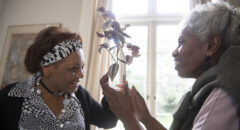
Tia Mowry-Hardrict knows the joys of growing up with a sibling, but she’s concerned about growing her young family due to her battle with a little talked about condition in Black women’s health: endometriosis.
The actress, author, wife and mother to 5-year-old son, Cree, recently told PEOPLE at the 2016 BET Awards,“I do suffer from endometriosis, so there’s a little bit of a challenge there.”
READ: Natural Remedies for Endometriosis
Mowry-Hardrict isn’t alone in her struggle with endometriosis, a gynecological disorder characterized by the growth of scar tissue outside the uterus and debilitating pain. The U.S. Department of Health and Human Services states that 5 million American women have endometriosis. However, little research has been conducted specific to Black women and endometriosis. In fact, studies have shown that the chronic pelvic pain many Black women experience is often misdiagnosed, especially if fibroids are present.
The American Congress of Obstetricians and Gynecologists states that endometriosis is often an underlying reason behind infertility, and affects 40% of women who suffer from infertility.
“Many think that endometriosis is a disease only associated with painful periods. In truth,endometriosis causes a number of health issues,” said Dr. Tamer Seckin, co-founder of the Endometriosis Foundation of America (EFA) in a press release. “It is the third leading cause of female infertility,” Dr. Seckin added.
Mowry-Hardrict shared that she and her husband, Cory Hardrict, are trying to get pregnant, “but I don’t want to put too much hope into it. I don’t want to be let down.”
READ: Endometriosis: What All Black Women Need To Know
What Causes Endometriosis
Physicians still are not clear on what causes endometriosis. They believe that menstrual tissue may back up in the fallopian tubes, the abdomen and grow causing endometriosis. Genetics may also play a part. This disease could be inherited, or it could result from genetic errors, making some women more likely than others to develop the condition.
Symptoms of endometriosis include:
- Pain before and during periods
- Pain with sex
- Infertility
- Fatigue
- Painful urination during periods
- Painful bowel movements during periods
- Other gastrointestinal upsets such as diarrhea, constipation and nausea
Additionally, women who have endometriosis may also have these conditions as well:
- Allergies
- Chemical sensitivities
- Frequent yeast infections
Treating & Lowering Risk for Endometriosis
There are some surgical procedures available to treat endometriosis. However, a change in diet could be the first step. According to Mowry-Hardrict, ““Endometriosis basically grows from inflammation.” She plans to follow a diet that gets rid of the inflammation in her body.








